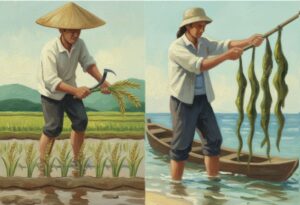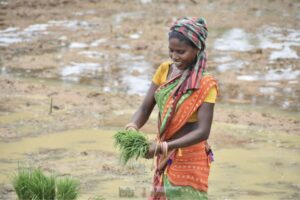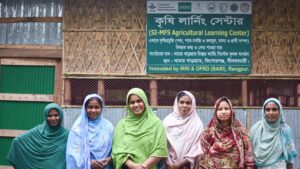
Japan is the only industrialized country whose agriculture is based on rice, its staple food. Rice cultivation in Japan was introduced from China between 13,000 and 300 BC. Since then, rice farming has had a great influence on the social structure and culture of the country.
Its rice ecosystems occur across a wide range of latitudes, including the subtropical, temperate, and subtemperate zones. Almost all rice is grown in summer under irrigated conditions. Most of its rice fields are on the plains of the country’s major river basins, but many rice fields are also found on terraces and in valleys.
Sacred rice
 In the 13th century, rice was Japan’s currency before China introduced metal, and rice had a political role—the rank of a feudal lord was determined by the amount of rice he produced or by the size of the rice producing area of his territory.
In the 13th century, rice was Japan’s currency before China introduced metal, and rice had a political role—the rank of a feudal lord was determined by the amount of rice he produced or by the size of the rice producing area of his territory.
In addition, the Japanese retain a unique regard for rice. For them, it is sacred. This reverence for rice is attributed to Shintoism, a Japanese religion. Shintoists believe that an emperor is a descendant of the creator of Japan, and that natural things and phenomena have deities—in rice resides the deity of food. This belief, among others, makes locally produced rice superior and totally different from foreign rice for the Japanese people.
Early rice science
The earliest recorded experiments on rice were in the 1400s and 1500s to determine its maturity, cultivation, traits, and glutinous properties.
By the 1800s, many farmers were carefully selecting rice varieties for planting. Afterward, the National Agricultural Experiment Station in Japan began selecting pure lines of rice varieties as soon as the station was established in 1893.
In 1905, Japan developed a rice seeder, called “octopus,” that could seed 16 hills in one move, and it was then widely adopted by farmers. Come 1910, the pedal thresher was invented in the country.
Japanese rice breeders began developing varieties for cold tolerance in 1935, and for blast resistance in the 1940s. They developed a series of rice varieties that had stiff straws, upright leaves, good response to fertilizer, and high yield potential.
In the early 1960s, rice consumption per capita was nearly 120 kilograms. Because of a high demand for rice, the government invested in research to generate better rice varieties and production techniques. The government even led a contest in search of a rice farmer with the highest yield in the country—the winner produced around 10 tons per hectare during that time.
A pioneering partner
Japan has been an important partner to the International Rice Research Institute (IRRI) since the Institute’sestablishment. It provided leadership by having a seat on the first IRRI board of trustees in the person of Dr. Hitoshi Kihara in 1960. Since then, Japan has always been represented on the board, with Dr. Mutsuo Iwamoto as its current representative. (Editor’s note: As of 2014, Dr. Akinori Noguch is the current member of the IRRI Board of the Trustees.)
Japan has also long been one of IRRI’s most generous supporters, giving a total of more than US$191 million to IRRI between 1971 and 2010. Japan became a member of the CGIAR in 1972.
Past research collaboration
In its partnership with Japan, IRRI covers a wide range of rice research. In 1984, Japanese scientists were assigned by the Japan International Research Center for Agricultural Sciences (JIRCAS) to work at IRRI headquarters under the IRRI-Japan Collaborative Research Project.
In the 1980s, research activities focused on developing low-nitrogeninput technology and on identifying genes that are resistant to various races of bacterial leaf blight disease. Then, in 1989, IRRI and Japan collaborated on rice double cropping. In 1994, their research concentrated on the adaptability of rice to water stress and blast disease. Under the Japan Capacity-Building Program, Japan continued to support breeding for blast resistance.
Japan also invested in research for better postharvest equipment that is now being adopted in Southeast Asia.
Moreover, the Japanese government has also supported social science research under the Japan-IRRI shuttle program. Through intensive field surveys in Asian villages, the research revealed how farmers rapidly modernized their farming once high-yielding varieties were introduced. It showed that modern rice technology has a significant impact on poverty alleviation, particularly among marginal farmers.
Japan has also supported IRRI to deliver rice market information and develop integrated rice cultivation systems under water-saving conditions. Japan also supported the successful development of submergence-tolerant rice (Sub1 rice).
Current work
IRRI and Japan are now working together in using molecular breeding techniques to develop high-yielding rice varieties under unfavorable conditions, such as drought. Several genes that help rice cope with drought stress have been previously identified and characterized by Japanese research groups at JIRCAS and RIKEN (a large natural sciences research institute).
Climate Change Adaptation in Rainfed Rice Areas (CCARA) is an ongoing research project under IRRI-Japan collaboration. It aims to develop a decision support system in rainfed lowland rice production based on seasonal weather prediction.
It is noteworthy to mention that, through JIRCAS and the Japan International Cooperation Agency (JICA), the country has also been a founding strategic partner in the Global Rice Science Partnership (GRiSP), being led by IRRI. Under this mega-program, activities include acceleration of the development of high-impact varieties in sub-Saharan Africa and Southeast Asia; acceleration of rice variety testing, approval, and dissemination to these regions; the building of a new generation of rice breeders; as well as conducting socioeconomic surveys.
Lastly, IRRI and JICA, working together in a project to train extension agronomists, recently brought 25 participants from five African countries (Mozambique, Kenya, Rwanda, Uganda, and Tanzania) to the Philippines for a 17-week rice knowledge, production, and extension course.










